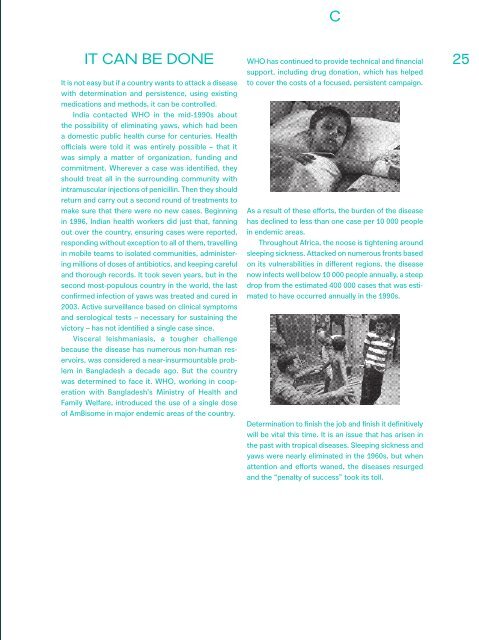You also want an ePaper? Increase the reach of your titles
YUMPU automatically turns print PDFs into web optimized ePapers that Google loves.
C<br />
IT CAN BE DONE<br />
It is not easy but if a country wants to attack a disease<br />
with determination and persistence, using existing<br />
medications and methods, it can be controlled.<br />
India contacted WHO in the mid-1990s about<br />
the possibility of eliminating yaws, which had been<br />
a domestic public health curse for centuries. Health<br />
officials were told it was entirely possible – that it<br />
was simply a matter of organization, funding and<br />
commitment. Wherever a case was identified, they<br />
should treat all in the surrounding community with<br />
intramuscular injections of penicillin. Then they should<br />
return and carry out a second round of treatments to<br />
make sure that there were no new cases. Beginning<br />
in 1996, Indian health workers did just that, fanning<br />
out over the country, ensuring cases were reported,<br />
responding without exception to all of them, travelling<br />
in mobile teams to isolated communities, administering<br />
millions of doses of antibiotics, and keeping careful<br />
and thorough records. It took seven years, but in the<br />
second most-populous country in the world, the last<br />
confirmed infection of yaws was treated and cured in<br />
2003. Active surveillance based on clinical symptoms<br />
and serological tests – necessary for sustaining the<br />
victory – has not identified a single case since.<br />
Visceral leishmaniasis, a tougher challenge<br />
because the disease has numerous non-human reservoirs,<br />
was considered a near-insurmountable problem<br />
in Bangladesh a decade ago. But the country<br />
was determined to face it. WHO, working in cooperation<br />
with Bangladesh’s Ministry of Health and<br />
Family Welfare, introduced the use of a single dose<br />
of AmBisome in major endemic areas of the country.<br />
WHO has continued to provide technical and financial<br />
support, including drug donation, which has helped<br />
to cover the costs of a focused, persistent campaign.<br />
As a result of these efforts, the burden of the disease<br />
has declined to less than one case per 10 000 people<br />
in endemic areas.<br />
Throughout Africa, the noose is tightening around<br />
sleeping sickness. Attacked on numerous fronts based<br />
on its vulnerabilities in different regions, the disease<br />
now infects well below 10 000 people annually, a steep<br />
drop from the estimated 400 000 cases that was estimated<br />
to have occurred annually in the 1990s.<br />
Determination to finish the job and finish it definitively<br />
will be vital this time. It is an issue that has arisen in<br />
the past with tropical diseases. Sleeping sickness and<br />
yaws were nearly eliminated in the 1960s, but when<br />
attention and efforts waned, the diseases resurged<br />
and the “penalty of success” took its toll.<br />
25


